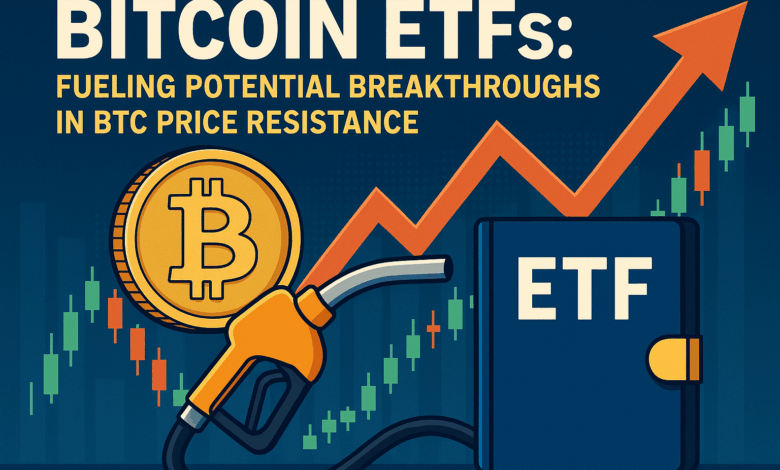Fueling Potential Breakthroughs in BTC Price Resistance

Bitcoin ETFs: The Inevitable Catalyst Wall Street Ignored
As traditional financial giants increasingly establish a foothold in the digital assets space, Bitcoin Exchange-Traded Funds (ETFs) are rising to prominence as a strategic gateway to mainstream adoption. While most media focus remains tied to Bitcoin’s short-term price swings and volatility, many miss the deeper transformation taking place. We are witnessing a shift from a retail-dominated market to institution-driven, long-term capital inflow. And at the front lines of this seismic transition are Bitcoin ETFs — vehicles that offer regulated, familiar access to the decentralized financial frontier.
For savvy investors who can look beyond day-to-day movements, Bitcoin ETFs are far more than just another investment product. These instruments represent a bridge between two financial worlds. On one side, we have Bitcoin, an asset born from distrust in centralized banking. On the other, we have legacy institutions whose very credibility lies in their regulatory compliance and risk management. The convergence of these forces marks a defining moment in crypto history — and yet, much of Wall Street remains stuck in cautious observation mode.
Why ETFs Matter More Than Ever
Exchange-Traded Funds revolutionized traditional finance by providing investors with transparent, liquid, and low-cost exposure to diversified assets. This democratization of investing is now arriving in the Bitcoin ecosystem. Spot Bitcoin ETFs give institutional and retail investors a streamlined, regulated channel for gaining exposure to BTC without requiring direct asset management, cold wallet storage, or understanding the technical nuances of private keys and blockchain confirmations.
The implications are profound. Each ETF share backed by physical BTC represents a withdrawal of supply from circulation. Unlike derivative-based exposure or synthetic tokens, spot ETFs must purchase and hold real Bitcoin in reserve. This accumulation gradually reduces the liquid supply accessible on open exchanges. Over time, basic supply-demand economics suggest upward pressure on price. If demand remains consistent or increases while the available BTC on-market decreases, the value of Bitcoin is likely to rise — perhaps significantly.
It’s crucial to revisit what Bitcoin (BTC) truly is. Far from just a speculative digital coin, Bitcoin is a provably scarce store of value, boasting a hard cap of 21 million coins. This scarcity, hardcoded in the protocol, resonates with institutional investors seeking an inflation-resistant hedge. ETFs, by facilitating large-scale exposure, are strengthening Bitcoin’s investment narrative as “digital gold.”
The Impact of ETFs on Bitcoin Price Dynamics
The disruptive effect of Bitcoin ETFs extends well beyond accessibility. Their emergence is transforming how Bitcoin’s price is discovered. Rather than the market being driven primarily by retail users reacting emotionally to tweets or media narratives, ETFs introduce steady and methodical capital deployment. Asset managers conducting large ETF purchases tend to follow strategic macroeconomic themes, execute on quarterly allocations, and make decisions based on diversified portfolio objectives rather than short-term hype.
What this does is fundamentally dampen price volatility in the long term. Instead of wild swings caused by sudden mass sell-offs, institutional ownership lowers volatility through slower, more deliberate movements. When ETFs steadily accumulate during market dips, they add invisible price floors. This cushions downward pressure and builds institutional “support zones” that new investors rely on when entering the market. Conversely, recoveries are often sharper due to constrained liquid supply — especially if those ETFs choose to hold rather than sell for long durations.
This shift creates a more stable environment, one that is more palatable to family offices, pension funds, and sovereign wealth managers. As traditional investors incrementally adopt Bitcoin through ETF vehicles, further confidence emerges, triggering a self-reinforcing feedback loop that drives long-term appreciation. The result? Bitcoin ceases to be viewed as risky speculation and starts to earn its place in conservative portfolios alongside gold, bonds, or broad equity indexes.
Recent ETF Inflows: A Contrarian Signal
In recent months, Bitcoin ETFs have experienced tremendous inflows, especially during periods of market uncertainty. Major institutional offerings such as BlackRock’s iShares Bitcoin Trust (IBIT) and Fidelity’s Wise Origin Bitcoin ETF have each secured billions of dollars in assets under management (AUM) within a short span following their launch. This is far from a retail-fueled flash-in-the-pan; it is coordinated, methodical acquisition by power players.
It’s worth noting that institutional adoption often trails retail speculation — but when the shift occurs, it often marks the start of a more sustained growth phase. The very nature of institutional investing is cautious, often waiting for regulatory clarity, auditor-reviewed structures, and liquidity depth before engaging. Now that those barriers are beginning to fall, we’re watching a crescendo of capital enter the market quietly, piece by piece.
While some traders frame this as a “top signal,” arguing that once institutions buy, most returns are priced in, history tells a different tale. Institutional investors are rarely early — but when they do arrive, they often make up for lost time by deploying large capital allocations strategically over time. This steady absorption sets up for constrained supply conditions and can lead to massive appreciation. For more insight into how these cycles unfold historically, read this Bitcoin Bull Market breakdown.
Target: $118,000 and Beyond
Some analysts and technologists have identified $118,000 as a key psychological threshold for Bitcoin. This target may seem ambitious, but it becomes much more realistic when you factor in the exponential impact of continued ETF inflows. Every institutional dollar serves not just to increase buying pressure, but to set new pricing norms. And unlike typical retail rallies driven by fear of missing out (FOMO), the ETF-driven rally is quieter but more persistent.
If current momentum holds — or accelerates — sell-side liquidity will continue to dry up. With ETFs reducing readily available supply, we approach a potential inflection point: the supply squeeze. At this junction, even modest new demand could result in outsized price movement. What differentiates this cycle from those of 2013 or 2017 is the type of capital involved. This time, it’s not driven by Reddit forums or meme hysteria — it’s driven by regulated capital with committee-approved mandates and fiduciary oversight.
As Wall Street makes its late entry, it brings not only capital but influence — changing the narrative and market perception of Bitcoin entirely. Instead of a volatile, fringe asset, it’s rebranded as a foundational allocation for forward-thinking portfolios. This makes long-term price projections like $118,000 not just possible, but increasingly likely. For broader projections and a more extensive strategic timeframe, read our comprehensive Bitcoin Price Prediction through 2030.
Investor Takeaways: Playing the ETF Wave
Bitcoin ETFs are not a passing trend — they are the new frontier for crypto adoption. For investors looking to position themselves wisely, here are key strategies:
- Monitor ETF inflows: Weekly SEC filings and fund reports give insight into how much BTC is being absorbed via ETFs. A rising share count or net AUM increase during consolidation phases can tip savvy investors off to underlying strength.
- Diversify your exposure: Blend ETF ownership with self-custodied Bitcoin for a hybrid approach. ETFs offer accessibility and simplicity, while direct BTC ownership gives full control and insulation from managerial risk.
- Act where institutions can’t: ETFs follow strict schedules and risk metrics. Retail investors can use their flexibility during market dips to build stronger positions beneath fair value, potentially outperforming passive ETF returns over time.
- Stay focused on macro trends: Forget daily candlesticks. Focus instead on regulatory approval timelines, ETF flow momentum, market-wide adoption rates, and Bitcoin’s halving cycles. These metrics are what move the needle long term.
Bottom line? The story of Bitcoin is no longer one of rebellion. With the arrival of ETFs and regulated capital, Bitcoin is stepping into the mainstream investment arena. Wall Street may have been slow to acknowledge the opportunity, but its involvement is now irreversible. The wave of institutional adoption is building — and those attuned to the ETF signal stand the best chance to ride its crest. Investors should no longer ponder if Bitcoin will break out — but rather how high it will go once it does.
Source link




